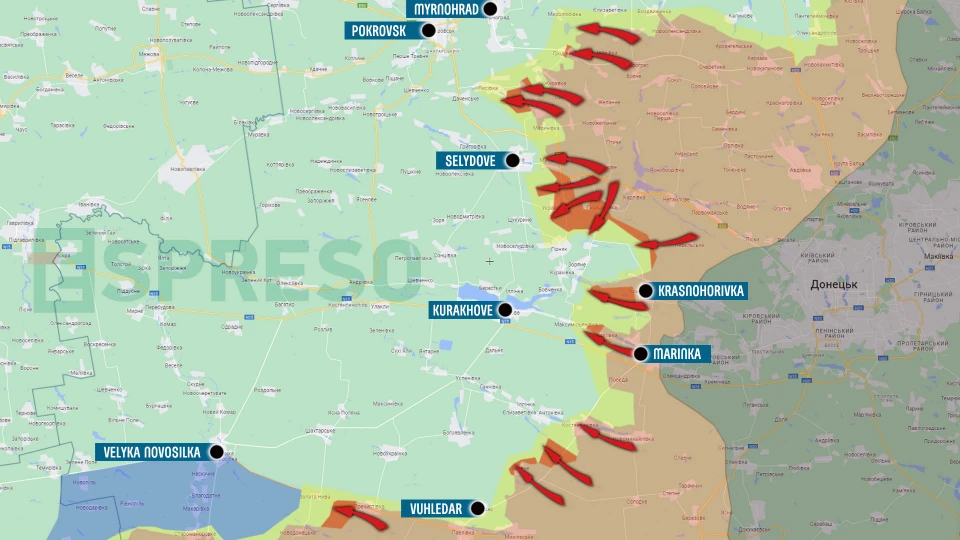
Russia pushes toward Kurakhove: fighting in Donetsk region and Ukraine's operation in Kursk region. Serhiy Zgurets' column
Russia is trying to advance along the Ukrainsk - Hirnyk - Kurakhivka line and further to Kurakhove. This is an important logistics center. The line of Ukrainian defense is Hirnyk, Kurakhivka, Oleksandropil, Maksymilianivka. The stability and duration of the Ukrainian defense depends on a number of factors
Fighting in the Donetsk region
The Russian army is trying to move to Kurakhove from Krasnohorivka through Hostre. The 46th Airmobile Brigade is stationed there. We know how effectively the brigade destroyed Russian equipment. Yesterday, there was a powerful Russia's offensive using armored vehicles in this area of the front. However, they failed to advance. However, it is likely that the Russians will continue to make such attempts.

Russia's movement up to Pokrovsk was suspended. There is no longer the same dynamics as before. Ukrainian forces are holding their positions behind Novohrodivka and Hrodivka. Russia has redirected its efforts to the south to capture Selydove, which it needs to protect its flanks during the offensive. Some experts believe that without the capture of Selydove, they will not move toward Pokrovsk. However, the Ukrainian Armed Forces have deployed new brigades to Selydove, and the town is currently being held, despite the fact that the Russian army is actively using armored personnel carriers, artillery, and especially drones to bypass Selydove from the north and south.
Over the last day, 226 combat clashes took place along the entire frontline. Out of 11 areas where the Russian enemy tried to break through Ukraine's defense line, 100 attacks took place in two areas - Pokrovsk and Kurakhove. Along the entire front line, especially in the Kurakhove - Vuhledar area, a significant number of armored vehicles - more than 80 units - were deployed to try to push Ukraine's defense line. The Russians used tanks, armored personnel carriers, and infantry fighting vehicles. They want to break through as much as possible, so they are using all their assets.
Situation in the Kursk sector
Ukrainian troops are conducting attacks in the Kursk region, where the Russian troops have been conducting a counteroffensive this week to push Ukrainian units out of certain areas in the Kursk region. A representative of Ukrainian military commandant's office in the Kursk region, Oleksii Dmytrashkivskyi, told AFP that Russia's counteroffensive has been stopped.
Russia regained control of Snagost and tried in vain to break through to the village of Lebedevka. As a result, the 51st Russian Airborne Regiment, which was advancing toward Lebedevka, lost five armored personnel carriers and temporarily went on the defensive. Probably, Russia's plan was to break through to Lebedevka, then to the Korenevo-Sudzha road, and to attack Sudzha from the east to undermine the logistics of the Ukrainian Armed Forces, which goes through Sudzha to the north to the positions of Ukrainian troops. But now Russia is forced to abandon these plans because it has to respond to the advance of Ukrainian forces from the villages of Veseloye and Medvezhye toward Korenevo.
NATO exercises
Today, NATO exercises in the Netherlands ended, with Ukraine participating for the first time. The exercises were aimed at taking into account Ukraine's experience in combating enemy drones, including Russian ones. 19 NATO countries took part in the exercise. The emphasis was on maximizing the use of Ukrainian experience to counter Russian means of attack. These exercises are related to the implementation of the roadmap for innovative cooperation between Ukraine and NATO. In Ukraine, innovations are systematically implemented at the level of the Brave1 defense cluster, which combines the capabilities of various agencies and is an integral platform for combining competencies and capabilities.
Oleh Donets, Head of Electronic Warfare Defense Tech at Brave1, said that some Ukrainian developments have already received NATO codification.
“Last year, when Brave1 was just launched, the area of EW was identified as one of our key priorities. Therefore, we have come a long way in more than a year of systematic work within the cluster and the cluster founders. Today, from the single manufacturers we had at the beginning, we have come to a fairly mature market, an established and expert environment, when we can offer a fairly large number of modern new developments that help and protect our soldiers. They are also quite effective and have something to share, have the experience that can be transferred to our partners. As of now, we have come a long way, and we have more than 180 developments of different directions, different types, from more than 120 manufacturers on the platform. We regularly codify these developments, and more than 30 developments have already received NATO codification. This allows the developments not only to be recognized in Ukraine and used in the Armed Forces, but also to be recognized in NATO countries and used by our partners,” he said.
Development of Ukrainian electronic warfare systems
The Head of EW Defense Tech noted that his company is now following the path of solving complex problems and finding integrated solutions.
“Electronic warfare is no exception. In the field of electronic warfare, we are also currently seeing the development of both short-range and more powerful means that can protect both infrastructure and some strategic objects. Therefore, in general, we are now observing the complexity of solutions and working to develop a common system of electronic warfare,” Donets said.
According to him, over the year of the grant program's operation, more than 329 developments have received grants from Brave1 and the state in the amount of more than $7.5 million.
“Among them, there is a significant number of developments in the field of electronic warfare - more than 16 teams that received grants worth about UAH 20 million. They have been funded, and today some have already fulfilled the conditions, while others are finalizing and implementing their solutions with these funds,” he added.
In addition, there is great interest from partners in the domestic defense technology market. Electronic warfare equipment is one of the highest priority areas: “We see a lot of interest. A number of companies work and communicate within the current legislative framework with international partners and companies. We know that there is such cooperation and communication, and it contributes to the efficiency and manufacturability of domestic producers,” said Donets.
He explained how interaction and coordination between developers and customers is ensured, taking into account the wishes of the military.
“Brave1 is an integration platform for all participants of the defense tech environment in Ukraine. Thanks to our platform and work, there is active communication between customers, operators, procurement departments, and manufacturers. Thanks to this, they communicate and actively exchange experience, which contributes to the faster development of the segment and the emergence of new models in the short term, respectively, on the battlefield. We constantly communicate and work with manufacturers. We note that as the market develops and expertise is gained, manufacturers are beginning to move away from purchasing components and move to their own developments. Therefore, the market has begun to actively focus on localizing various components and organizing its own production. We note a steady trend towards deepening expertise and production of own components, including in the field of electronic warfare,” he said.
Donets explained in which direction the electronic warfare trends will develop, particularly this year.
“The dynamics of changing frequency bands on the battlefield has accelerated. Accordingly, there is a great deal of change both up and down the range, which forces manufacturers to look for new approaches, solutions and make their products more flexible. Therefore, in general, we will see the emergence of more flexible means, more complex means that will combine various components, including detection components, which will allow these means to be more effective in the ranges used by the enemy,” he said.
One of the main priorities of Brave1 is cooperation of manufacturers from different industries
“This is a war of technology, robots and unmanned systems. That is why, of course, electronic warfare equipment installed on certain unmanned systems is actively appearing today. They are also developing and evolving. No one can say that it will be exactly as we see it now. But at the same time, there is active cooperation between manufacturers, and this is exactly what we are actively working on. This is also one of the main priorities of Brave1 - cooperation of manufacturers from different industries. We are actively working in this direction, and I think we will see more and more such developments in the near future. They will be in different directions. Each of them will be looking for its own way, but they will be focused on protecting our soldiers, reducing their presence in the hottest spots, creating more protection and saving more soldiers. We are actively developing and implementing solutions that allow us to be effective as UAVs and to effectively use our electronic warfare assets to counter enemy UAVs,” he summarized.
- News














































